Modern digital marketing thrives on personalization — users expect tailored content, and businesses rely on data-driven decision-making to deliver results. OptiMonk, a platform designed to boost on-site conversion rates with personalized popups and messages, has leaned into the segmentation trend. However, sometimes even a great tool can have its setbacks. This article dives into how OptiMonk’s segmentation API began returning stale audience data, disrupting targeted campaigns, and how a webhook replay system paired with an audience refresh method helped solve the issue.
TL;DR
OptiMonk’s segmentation API began delivering outdated audience data, which caused marketing campaigns to target the wrong user segments. To resolve this, the developer implemented a system using webhook replays and periodic audience refreshes to ensure data was synced accurately. This approach helped restore real-time targeting precision. The solution also improved the integrity of personalization logic across multiple campaigns and platforms.
Understanding the Problem: Stale Audiences from OptiMonk’s API
The segmentation API is supposed to return up-to-date audience data based on various filters and triggers — location, device type, shopping behavior, and more. A key part of this functionality is syncing user behavior instantly whenever a trigger condition is met. But in this case, the API started returning outdated user segmentation data. Campaigns were firing for users who no longer qualified or, worse, missing qualified leads altogether.
Even though the segmentation criteria were defined clearly within the OptiMonk UI, external API pull requests often returned inconsistent results. These typically showed user data that was either hours or even days old. This caused:
- Mismatched campaigns: Offers displayed to the wrong audiences.
- Lost conversions: Abandoned cart users didn’t see retention popups.
- Inefficient targeting logic: High-level personalization processes broke.

After verifying that it wasn’t a UI bug, logs were checked from API endpoints and internal caches. Everything pointed to a lag in how audiences were being updated. This demanded a workaround — keeping audiences truly updated even when the API didn’t.
The Workaround: Webhook Replay + Audience Refresh
To counter the staleness of OptiMonk’s segmentation data, a workaround was devised involving two central improvements:
- Webhook Replay System: Re-consume webhook events that may have failed or arrived too early/late.
- Audience Refresh Logic: Periodically compare and update segmentation data against real user behavior.
1. Webhook Replay System
OptiMonk allows webhooks that trigger when specific user actions happen — like visiting a product page or abandoning a cart. However, sometimes these webhooks might not sync with third-party systems properly due to delays, network issues, or changed conditions by the time they’re received.
The solution began by building a lightweight middleware layer. All incoming webhooks were logged with timestamps and payload. If a webhook failed, took too long, or didn’t match the current user state, it would be replayed at intervals (every five minutes, configurable).
This made sure that no webhook-based triggers were lost. It also allowed replaying messages when a new campaign condition was added — retroactively factoring the user into newer audience groups.
2. Audience Refresh System
A segmentation cache or snapshot was stored for each user. At fixed intervals (e.g., every hour), user activity data from the source of truth (like a backend CRM or primary analytics DB) was reconciled with the segmentation data OptiMonk had returned initially.
When discrepancies were identified — for example, a user recently purchased but was still labeled as “high interest but non-buyer” — an API call was made to re-sync the segmentation via OptiMonk’s update endpoints.
This logic ensured that stale data wouldn’t persist beyond a short window and meant the campaigns could rely on relatively accurate, ledger-worthy information.

Results of the Update Sync Layer
The implementation of webhook replays and audience refresh significantly improved campaign quality and ROI. Specifically:
- Campaign Targeting Accuracy: Increased by over 35% — fewer irrelevant popups.
- Conversion Rates: Grew steadily by optimizing timing and relevance of displays.
- Operational Efficiency: Reduced debugging time for segmentation issues by 60%.
Another hidden benefit was scalability; newly created campaigns instantly tapped into dynamic lead lists using the webhook history, without waiting for fresh site behavior to occur. This helped launch retargeting flows faster and experiment with micro-segments effectively.
Challenges Faced During Implementation
No workaround is flawless, and building this sync layer also had its obstacles:
- Webhook Order-of-Execution Problems: Replay logic sometimes interfered with live behavior. Ordered queuing had to be added.
- API Rate Limits: Triggering too many updates caused throttling. A smart jittered scheduling mechanism was implemented.
- Partial Data Matches: Defined logic had to handle fuzzy data where not all attributes matched exactly.
Solving these required building test harnesses to simulate various user journeys and webhook failures. Eventually, the system stabilized into a robust syncing service that now runs parallel to OptiMonk’s native engine to cover the edge cases.
Lessons Learned
This project was a classic example of identifying platform limitations and bridging them through engineering creativity. While OptiMonk remains a powerful platform, relying solely on its real-time segmentation API was insufficient for multi-channel operations or dynamic targeting at scale.
Main takeaways:
- Always assume webhooks may fail or be delayed.
- Audience snapshots and scheduled refreshes give you a second line of defense.
- Set up visibility dashboards — don’t fly blind with external APIs.
FAQ
Why was OptiMonk returning stale audience data?
It appeared to be a delay between user behavior and when the segmentation engine updated audience tags. Cached API responses or internal re-evaluation throttles may play a role.
Can this solution be applied to other platforms?
Yes. The combination of webhook monitoring and periodic re-evaluation is platform-agnostic and useful for any system that relies on external segmentation metrics.
How often should the audience refresh run?
It depends on the velocity of user behavior — for e-commerce, every 15–60 minutes is a good balance between accurate data and rate limits.
Are there any libraries or frameworks recommended?
Use frameworks like Node.js with libraries such as BullMQ or Agenda for job queues. Python’s Celery can also work well for task scheduling.
What’s the cost of polling the API so frequently?
It can be non-trivial depending on volume and rate limits. You may need caching and conditional requests to optimize costs and stay compliant with API terms.


